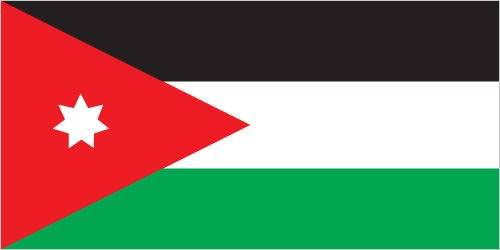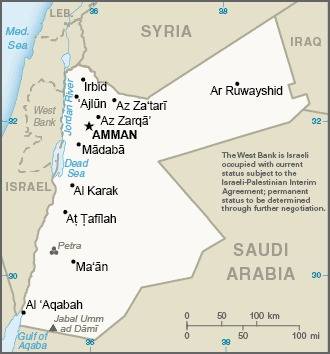146 Jordan

Three equal horizontal bands of black (top), representing the Abbassid Caliphate, white, representing the Ummayyad Caliphate, and green, representing the Fatimid Caliphate. A red isosceles triangle on the hoist side, representing the Great Arab Revolt of 1916, and bearing a small white seven-pointed star symbolizing the seven verses of the opening Sura (Al-Fatiha) of the Holy Koran. The seven points on the star represent faith in One God, humanity, national spirit, humility, social justice, virtue, and aspirations. Design is based on the Arab Revolt flag of World War I.
Flag courtesy of the CIA World Factbook

Map courtesy of the CIA World Factbook

The “Treasury” building (Al-Khazneh) at Petra was carved into the red-hued cliff face in the 2nd century B.C.
Photo courtesy of the CIA World Factbook
Government
According to Britannica, the 1952 constitution is the most recent of a series of legislative instruments that, both before and after independence, have increased executive responsibility. The constitution declares Jordan to be a constitutional, hereditary monarchy with a parliamentary form of government. Islam is the official religion, and Jordan is declared to be part of the Arab ummah (“nation”). The king remains the country’s ultimate authority and wields power over the executive, legislative, and judicial branches. Jordan’s central government is headed by a prime minister appointed by the king, who also chooses the cabinet. According to the constitution, the appointments of both prime minister and cabinet are subject to parliamentary approval. The cabinet coordinates the work of the different departments and establishes general policy.
Jordan’s constitution provides for a bicameral National Assembly (Majlis al-Ummah), with a Senate (Majlis al-Aʿyan) as its upper chamber, and a House of Representatives (Majlis al-Nuwwāb) as its lower chamber. The aʿyan (“notables”) of the Senate are appointed by the king for four-year terms; elections for the nuwwāb (“deputies”) of the House of Representatives, scheduled at least every four years, frequently have been suspended. A small number of seats in the House of Representatives are reserved for Christians and Circassians. The ninth parliament, elected in 1965, was prorogued several times before being replaced in 1978 by the National Consultative Council, an appointed body with reduced power that debates government programs and activities. The parliament was reconvened, however, in a special session called in January 1984. Since then the parliament has been periodically suspended: from 1988, when Jordan severed its ties with the West Bank, until 1989 and from August until November 1993, when the country held its first multiparty elections since 1956. In 2001 the king dissolved the Majlis al-Nuwwāb to reformulate the electoral system; new deputies were elected in 2003.
Jordan is divided into 12 administrative muḥāfaẓāt (governorates), which in turn are divided into districts and subdistricts, each of which is headed by an official appointed by the minister of the interior. Cities and towns each have mayors and partially elected councils.
The judiciary is constitutionally independent, though judges are appointed and dismissed by royal irādah (“decree”) following a decision made by the Justices Council. There are three categories of courts. The first category consists of regular courts, including those of magistrates, courts of first instance, and courts of appeals and cassation in Amman, which hear appeals passed on from lower courts. The constitution also provides for the Diwān Khāṣṣ (Special Council), which interprets the laws and passes on their constitutionality. The second category consists of Sharīʿah (Islamic) courts and other religious courts for non-Muslims; these exercise jurisdiction over matters of personal status. The third category consists of special courts, such as land, government, property, municipal, tax, and customs courts.
Jordanian Civil Aviation Regulatory Commission (CARC)
The Jordanian Civil Aviation Regulatory Commission (CARC) was created to provide guidance, assistance and to maintain communication with all stakeholders in the civil aviation sector, and clarify CARC regulations, procedures and various services to all their partners. CARC maintains its commitment in managing its functions and responsibilities in accordance with the National and International Civil Aviation Legislations to insure the maximum level of aviation safety, security, environment protection and the sustainability and growth of the aviation sector.
Airspace
SkyVector – Google Maps – ADS-B Exchange
ICAO countries publish an Aeronautical Information Publication (AIP). This document is divided into three parts: General (GEN), En Route (ENR) and Aerodromes (AD). ENR 1.4 details the types of airspace classes they chose to adopt from classes A through G.
Jordan AIP – requires login information
Drone Regulations
Unmanned Aircraft Design and Production
Unmanned Aircraft Maintenance and Continuing Airworthiness Organization
Drones Operations Approval Application Form
Advanced Air Mobility (AAM) Regulations & Policies
Advanced Air Mobility (AAM) News
2025
Video courtesy of Advanced Air Mobility Institute from the July 2025 Global AAM Forum.
2025
Video courtesy of Advanced Air Mobility Institute from the January 2025 Global AAM Forum. Complete session for Day 3 of this Forum is available on the Advanced Air Mobility Institute YouTube Channel
Short Essay Questions
Scenario-Based Question
You have been hired by a Drone Startup Company. Your boss has immediately assigned this job to you.
They need you to prepare a one-page memo detailing the legalities of using a drone to film Petra, pictured above.
They need you to mention any national laws and local ordinances.
They specifically want to know what airspace (insert pictures) you will be operating in and whether or not you need an airspace authorization.
Does it matter whether or not you are a citizen of the country?
Lastly, there is a bonus for you if, as you scroll through this chapter, you find any typos or broken links!
Short Essay Questions
- What are the drone categories?
- How is registration addressed?
- How is remote ID addressed?
- What are the model aircraft rules?
- What are the commercial drone rules?
- Are there waivers or exemptions to the rules? If so, for what?
- Would you share a link to an interactive airspace map?
- How is BVLOS addressed?
- How can you fly drones at night?
- How can you fly drones over people?
- Where do you find drone NOTAMs?
- What are the rules for drone maintenance?
- What are the rules for an SMS program?
- What are some unique rules not mentioned above?
- What are the C-UAS rules?
- What are the AAM rules?

